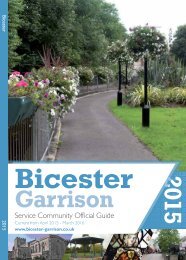Shrivenham 2015
Annual guide for serving personnel and their families in the Shrivenham station detailing Local Amenities, Housing, Education & Leisure activities in the area.
Annual guide for serving personnel and their families in the Shrivenham station detailing Local Amenities, Housing, Education & Leisure activities in the area.
You also want an ePaper? Increase the reach of your titles
YUMPU automatically turns print PDFs into web optimized ePapers that Google loves.
The Garrison Station<br />
Joint Services Command and Staff College<br />
Background<br />
Following studies in 1994, the United Kingdom Ministry<br />
of Defence announced a number of major tri-Service<br />
initiatives. The first to take effect was the establishment<br />
of the Permanent Joint Headquarters (PJHQ) at<br />
Northwood in North London in April 1996 to plan<br />
and execute UK led joint, combined and multinational<br />
operations. The second was the formation of the<br />
Joint Rapid Development Force in August 1996 (since<br />
renamed the Joint Rapid Reaction Force) as a joint force<br />
of up to reinforced brigade size, drawn from assigned<br />
units, capable of rapid and global intervention across a<br />
wide spectrum of conflict. The third was the creation of<br />
the Joint Services Command and Staff College (JSCSC)<br />
in January 1997. In the case of JSCSC the Chiefs of Staff<br />
wished to:<br />
• Maximise the opportunities for the common<br />
understanding of the approach to warfare and defence<br />
as a whole, consistent with the increasing importance<br />
of the joint, combined, multinational and inter-agency<br />
nature of future operations.<br />
• Provide the potential for future development of the<br />
Staff College on a combined and inter-agency basis.<br />
The formation of the JSCSC involved the closure of the<br />
four former Staff Colleges in the United Kingdom – the<br />
Joint Services Defence College and the Royal Naval<br />
Staff College at Greenwich, the Army Command and<br />
Staff College at Camberley and the Royal Air Force Staff<br />
College at Bracknell. The JSCSC was based at Bracknell<br />
from 1997 to 2000 on the site of the former Royal<br />
Air Force Staff College, and moved to the new site at<br />
<strong>Shrivenham</strong> in August 2000. The three Component<br />
Divisions – Royal Navy Division (RND), Army Division<br />
(AD) and Royal Air Force Division (RAFD) also moved to<br />
the new JSCSC at <strong>Shrivenham</strong> in August 2000, enabling<br />
all military command and staff training to be delivered<br />
from one site.<br />
The JSCSC trains future commanders and staff officers<br />
from all of the UK Armed Services and the Civil Service<br />
as well as military officers from many countries around<br />
the world.<br />
Its mission is: to provide world class Command and Staff<br />
education and training, in order to enhance operational<br />
capability, thereby advancing the Defence and Security<br />
interests of the United Kingdom.<br />
Its principle courses include:<br />
• The Higher Command and Staff Course (HCSC) – an<br />
annual, 16 week course for approximately 33 one<br />
star and Colonel or Service equivalent level officers<br />
from all three Services, NATO nations and some<br />
Government departments.<br />
• The Advanced Command and Staff Course (ACSC)<br />
– an annual, 40 week course for 280 officers at Major<br />
to Lieutenant Colonel and Service equivalents from all<br />
three Services, MOD Civil Servants and International<br />
Officers from almost 50 nations.<br />
• Component staff training courses for all three Services,<br />
comprising a range of shorter courses that are aimed<br />
at junior and intermediate staff training for officers<br />
between the ages of 26 and 34. This is delivered<br />
by the RN Division, the Army Division and the RAF<br />
Division.<br />
• Other courses and exercises include those for Reserve<br />
officers and preparation for those about to attend staff<br />
training overseas.<br />
College Badge<br />
The College Badge was painted<br />
by a heraldic artist of the College<br />
of Arms. The design is based<br />
on the original badge granted to<br />
the Joint Services Staff College at<br />
Latimer in 1948 and has changed<br />
little during the College’s various<br />
incarnations: the Joint Services<br />
Staff College (1946-1971);<br />
the National Defence College<br />
(1971-1982) the Joint Services<br />
Defence College (1982-1997); and now the Joint<br />
Services Command and Staff College (since 1997). The<br />
College Motto ‘Unity is Strength’ was proposed by the<br />
first commandant of the Joint Services Staff College, Rear<br />
Admiral CE Douglas-Pennant CB CBE DSO DSC.<br />
The badge has at its centre the Cormorant which was<br />
chosen as the College emblem by the Joint Services<br />
Staff College in March 1947 following a proposed<br />
design by Lieutenant Colonel J B Adams, a member of<br />
the Directing Staff. He explained that the Cormorant<br />
was a land based sea-bird and, as such, was considered<br />
appropriate in view of its adaptability between the three<br />
environments in which the Services operate; land, sea<br />
and air. It also maintains the custom of the single-Service<br />
Staff Colleges at Greenwich, Camberley and Bracknell of<br />
having a bird as an emblem.<br />
Further embellishments to the badge include, below the<br />
image, a Naval Crown, Crossed Swords and Air Force<br />
Wings. The Royal Crown, which marks the reign of HM<br />
Queen Elizabeth II, surmounts the Badge.<br />
Page 8<br />
The Station



